Research Proposal on Staff Turnover Impact on Unilever Profitability
VerifiedAdded on 2023/06/07
|6
|1260
|95
Report
AI Summary
This research proposal aims to analyze the impact of staff turnover as a business issue on the profitability of the retail industry, focusing on Unilever. The objectives include understanding the concept of staff turnover, analyzing contributing factors within the retail industry, assessing the relationship between staff turnover and Unilever's profitability, and suggesting strategies for improvement. Key research questions address the meaning of staff turnover, contributing factors in the retail industry, the relationship with Unilever's profitability, and potential improvement strategies. The literature review highlights employee turnover definitions, factors affecting turnover intention (communication, job satisfaction, culture), and the link between low staff turnover and increased profitability. The research methodology outlines a qualitative research type, inductive approach, interpretivism philosophy, and descriptive research design, utilizing primary and secondary data collection methods with ethical considerations. References to relevant books and journals are provided.
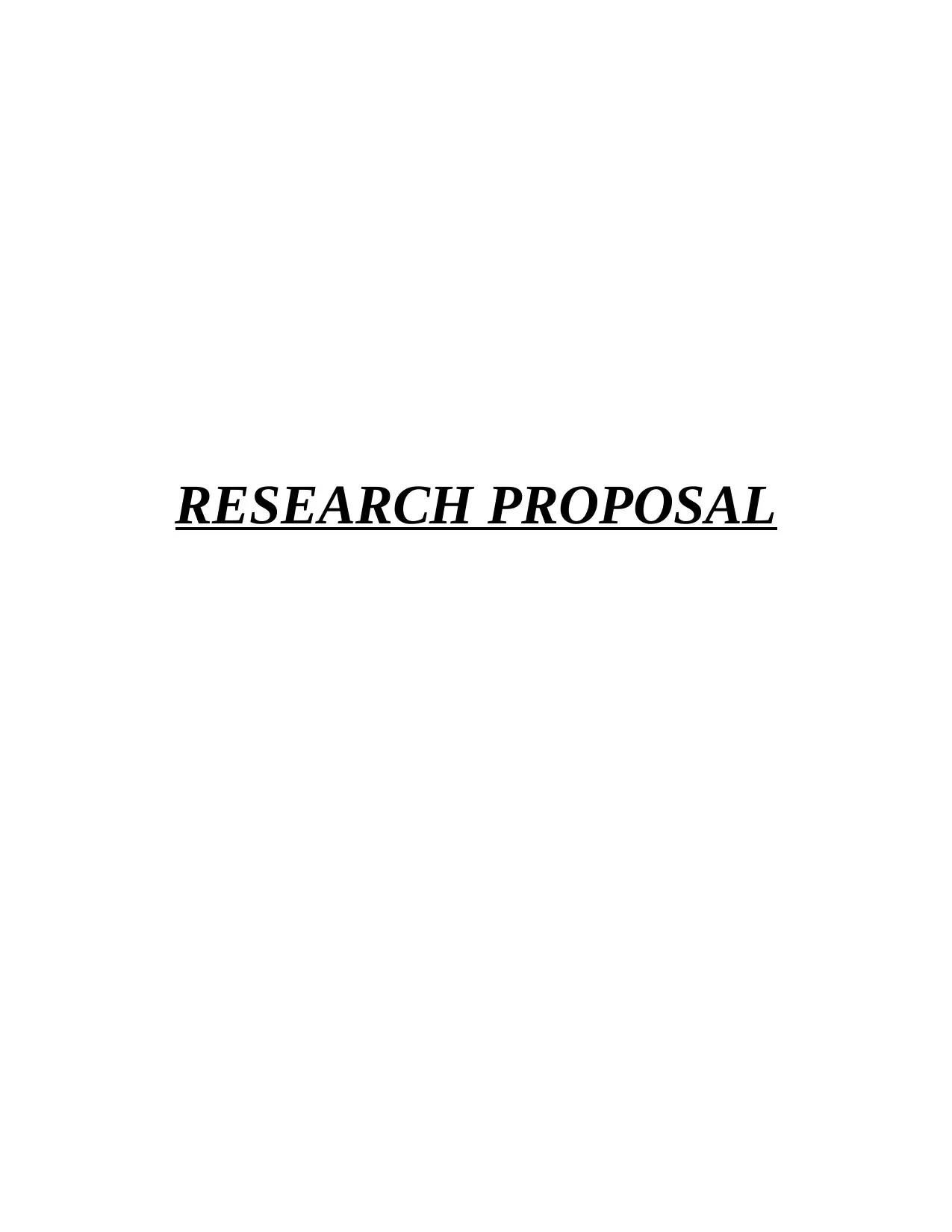
RESEARCH PROPOSAL
Paraphrase This Document
Need a fresh take? Get an instant paraphrase of this document with our AI Paraphraser
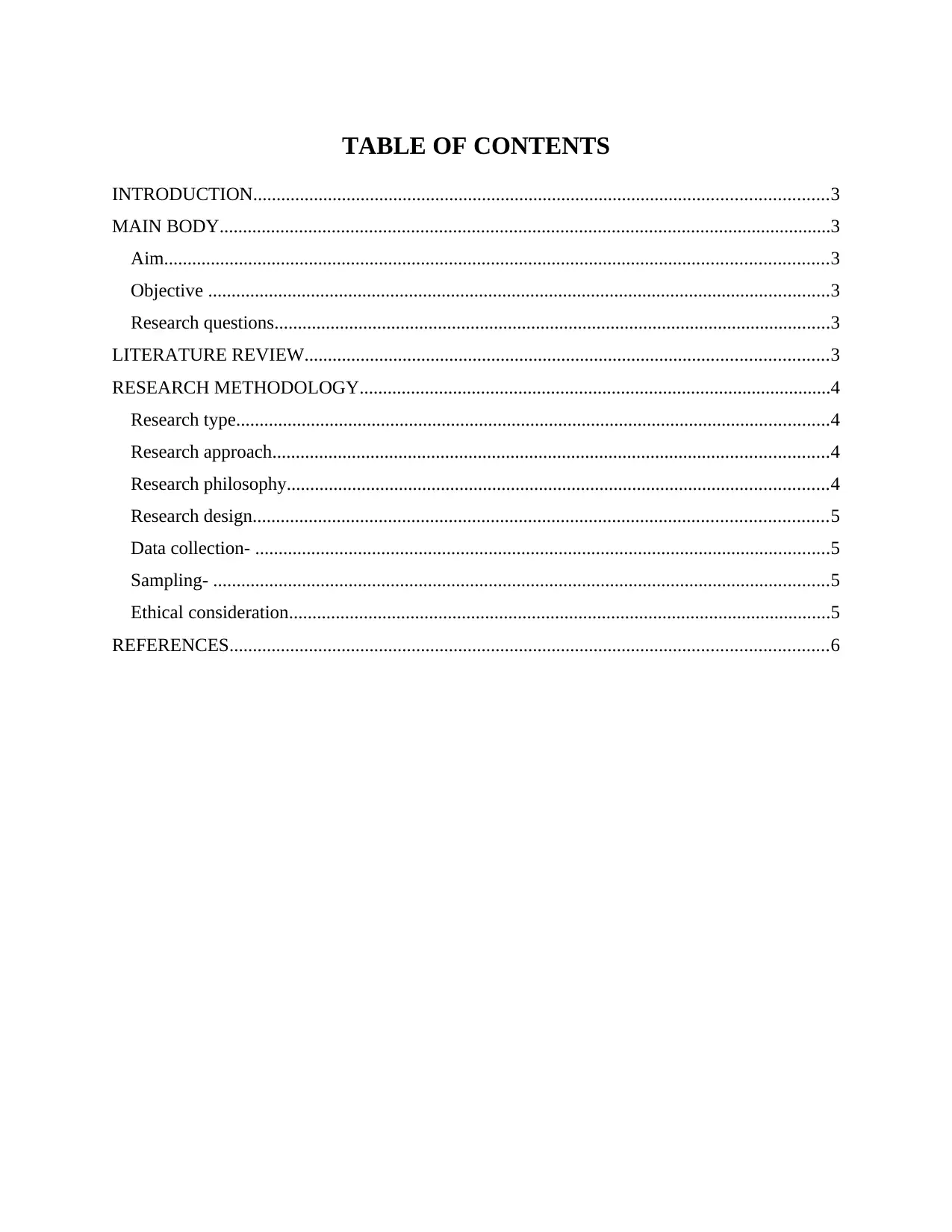
TABLE OF CONTENTS
INTRODUCTION...........................................................................................................................3
MAIN BODY...................................................................................................................................3
Aim..............................................................................................................................................3
Objective .....................................................................................................................................3
Research questions.......................................................................................................................3
LITERATURE REVIEW................................................................................................................3
RESEARCH METHODOLOGY.....................................................................................................4
Research type...............................................................................................................................4
Research approach.......................................................................................................................4
Research philosophy....................................................................................................................4
Research design...........................................................................................................................5
Data collection- ...........................................................................................................................5
Sampling- ....................................................................................................................................5
Ethical consideration....................................................................................................................5
REFERENCES................................................................................................................................6
INTRODUCTION...........................................................................................................................3
MAIN BODY...................................................................................................................................3
Aim..............................................................................................................................................3
Objective .....................................................................................................................................3
Research questions.......................................................................................................................3
LITERATURE REVIEW................................................................................................................3
RESEARCH METHODOLOGY.....................................................................................................4
Research type...............................................................................................................................4
Research approach.......................................................................................................................4
Research philosophy....................................................................................................................4
Research design...........................................................................................................................5
Data collection- ...........................................................................................................................5
Sampling- ....................................................................................................................................5
Ethical consideration....................................................................................................................5
REFERENCES................................................................................................................................6
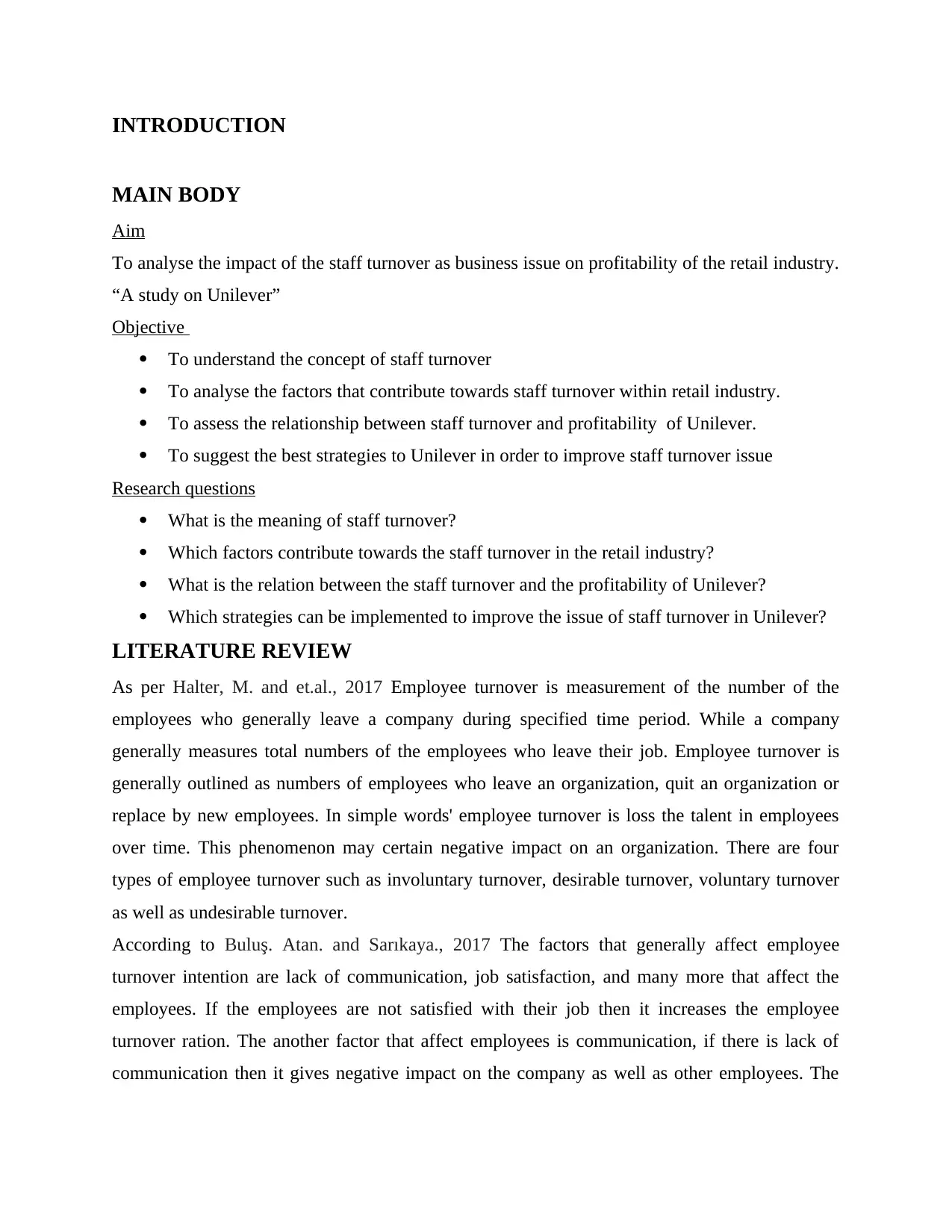
INTRODUCTION
MAIN BODY
Aim
To analyse the impact of the staff turnover as business issue on profitability of the retail industry.
“A study on Unilever”
Objective
To understand the concept of staff turnover
To analyse the factors that contribute towards staff turnover within retail industry.
To assess the relationship between staff turnover and profitability of Unilever.
To suggest the best strategies to Unilever in order to improve staff turnover issue
Research questions
What is the meaning of staff turnover?
Which factors contribute towards the staff turnover in the retail industry?
What is the relation between the staff turnover and the profitability of Unilever?
Which strategies can be implemented to improve the issue of staff turnover in Unilever?
LITERATURE REVIEW
As per Halter, M. and et.al., 2017 Employee turnover is measurement of the number of the
employees who generally leave a company during specified time period. While a company
generally measures total numbers of the employees who leave their job. Employee turnover is
generally outlined as numbers of employees who leave an organization, quit an organization or
replace by new employees. In simple words' employee turnover is loss the talent in employees
over time. This phenomenon may certain negative impact on an organization. There are four
types of employee turnover such as involuntary turnover, desirable turnover, voluntary turnover
as well as undesirable turnover.
According to Buluş. Atan. and Sarıkaya., 2017 The factors that generally affect employee
turnover intention are lack of communication, job satisfaction, and many more that affect the
employees. If the employees are not satisfied with their job then it increases the employee
turnover ration. The another factor that affect employees is communication, if there is lack of
communication then it gives negative impact on the company as well as other employees. The
MAIN BODY
Aim
To analyse the impact of the staff turnover as business issue on profitability of the retail industry.
“A study on Unilever”
Objective
To understand the concept of staff turnover
To analyse the factors that contribute towards staff turnover within retail industry.
To assess the relationship between staff turnover and profitability of Unilever.
To suggest the best strategies to Unilever in order to improve staff turnover issue
Research questions
What is the meaning of staff turnover?
Which factors contribute towards the staff turnover in the retail industry?
What is the relation between the staff turnover and the profitability of Unilever?
Which strategies can be implemented to improve the issue of staff turnover in Unilever?
LITERATURE REVIEW
As per Halter, M. and et.al., 2017 Employee turnover is measurement of the number of the
employees who generally leave a company during specified time period. While a company
generally measures total numbers of the employees who leave their job. Employee turnover is
generally outlined as numbers of employees who leave an organization, quit an organization or
replace by new employees. In simple words' employee turnover is loss the talent in employees
over time. This phenomenon may certain negative impact on an organization. There are four
types of employee turnover such as involuntary turnover, desirable turnover, voluntary turnover
as well as undesirable turnover.
According to Buluş. Atan. and Sarıkaya., 2017 The factors that generally affect employee
turnover intention are lack of communication, job satisfaction, and many more that affect the
employees. If the employees are not satisfied with their job then it increases the employee
turnover ration. The another factor that affect employees is communication, if there is lack of
communication then it gives negative impact on the company as well as other employees. The
⊘ This is a preview!⊘
Do you want full access?
Subscribe today to unlock all pages.

Trusted by 1+ million students worldwide
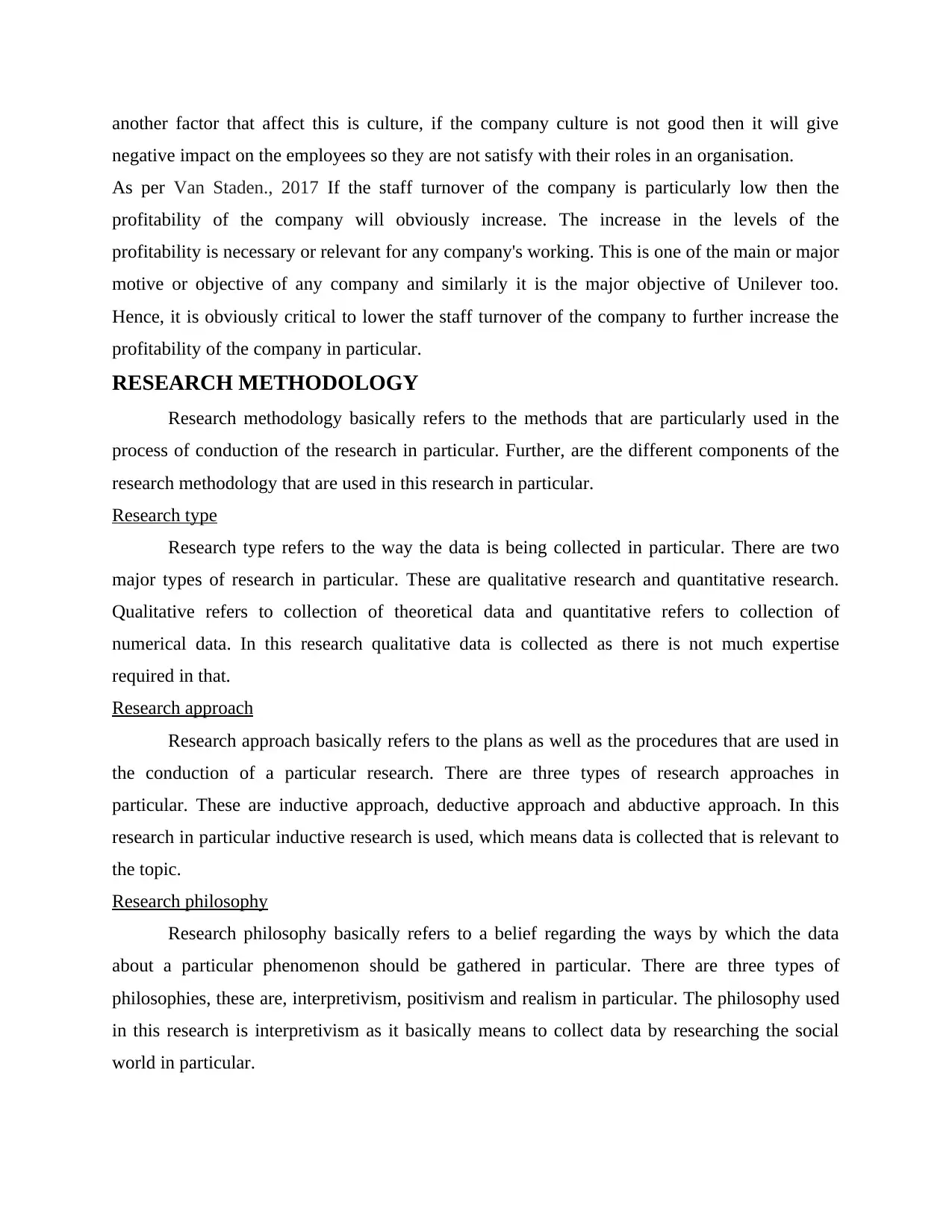
another factor that affect this is culture, if the company culture is not good then it will give
negative impact on the employees so they are not satisfy with their roles in an organisation.
As per Van Staden., 2017 If the staff turnover of the company is particularly low then the
profitability of the company will obviously increase. The increase in the levels of the
profitability is necessary or relevant for any company's working. This is one of the main or major
motive or objective of any company and similarly it is the major objective of Unilever too.
Hence, it is obviously critical to lower the staff turnover of the company to further increase the
profitability of the company in particular.
RESEARCH METHODOLOGY
Research methodology basically refers to the methods that are particularly used in the
process of conduction of the research in particular. Further, are the different components of the
research methodology that are used in this research in particular.
Research type
Research type refers to the way the data is being collected in particular. There are two
major types of research in particular. These are qualitative research and quantitative research.
Qualitative refers to collection of theoretical data and quantitative refers to collection of
numerical data. In this research qualitative data is collected as there is not much expertise
required in that.
Research approach
Research approach basically refers to the plans as well as the procedures that are used in
the conduction of a particular research. There are three types of research approaches in
particular. These are inductive approach, deductive approach and abductive approach. In this
research in particular inductive research is used, which means data is collected that is relevant to
the topic.
Research philosophy
Research philosophy basically refers to a belief regarding the ways by which the data
about a particular phenomenon should be gathered in particular. There are three types of
philosophies, these are, interpretivism, positivism and realism in particular. The philosophy used
in this research is interpretivism as it basically means to collect data by researching the social
world in particular.
negative impact on the employees so they are not satisfy with their roles in an organisation.
As per Van Staden., 2017 If the staff turnover of the company is particularly low then the
profitability of the company will obviously increase. The increase in the levels of the
profitability is necessary or relevant for any company's working. This is one of the main or major
motive or objective of any company and similarly it is the major objective of Unilever too.
Hence, it is obviously critical to lower the staff turnover of the company to further increase the
profitability of the company in particular.
RESEARCH METHODOLOGY
Research methodology basically refers to the methods that are particularly used in the
process of conduction of the research in particular. Further, are the different components of the
research methodology that are used in this research in particular.
Research type
Research type refers to the way the data is being collected in particular. There are two
major types of research in particular. These are qualitative research and quantitative research.
Qualitative refers to collection of theoretical data and quantitative refers to collection of
numerical data. In this research qualitative data is collected as there is not much expertise
required in that.
Research approach
Research approach basically refers to the plans as well as the procedures that are used in
the conduction of a particular research. There are three types of research approaches in
particular. These are inductive approach, deductive approach and abductive approach. In this
research in particular inductive research is used, which means data is collected that is relevant to
the topic.
Research philosophy
Research philosophy basically refers to a belief regarding the ways by which the data
about a particular phenomenon should be gathered in particular. There are three types of
philosophies, these are, interpretivism, positivism and realism in particular. The philosophy used
in this research is interpretivism as it basically means to collect data by researching the social
world in particular.
Paraphrase This Document
Need a fresh take? Get an instant paraphrase of this document with our AI Paraphraser
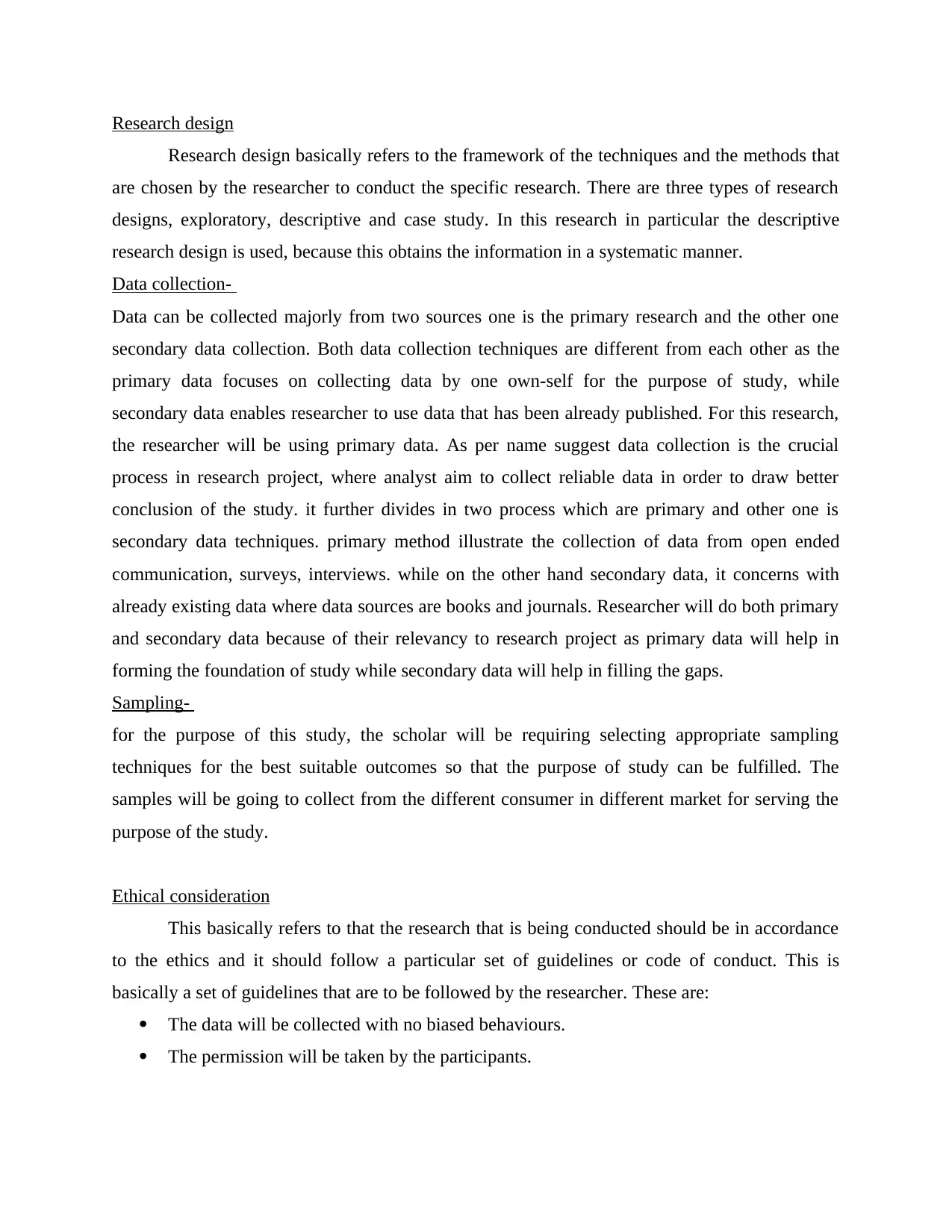
Research design
Research design basically refers to the framework of the techniques and the methods that
are chosen by the researcher to conduct the specific research. There are three types of research
designs, exploratory, descriptive and case study. In this research in particular the descriptive
research design is used, because this obtains the information in a systematic manner.
Data collection-
Data can be collected majorly from two sources one is the primary research and the other one
secondary data collection. Both data collection techniques are different from each other as the
primary data focuses on collecting data by one own-self for the purpose of study, while
secondary data enables researcher to use data that has been already published. For this research,
the researcher will be using primary data. As per name suggest data collection is the crucial
process in research project, where analyst aim to collect reliable data in order to draw better
conclusion of the study. it further divides in two process which are primary and other one is
secondary data techniques. primary method illustrate the collection of data from open ended
communication, surveys, interviews. while on the other hand secondary data, it concerns with
already existing data where data sources are books and journals. Researcher will do both primary
and secondary data because of their relevancy to research project as primary data will help in
forming the foundation of study while secondary data will help in filling the gaps.
Sampling-
for the purpose of this study, the scholar will be requiring selecting appropriate sampling
techniques for the best suitable outcomes so that the purpose of study can be fulfilled. The
samples will be going to collect from the different consumer in different market for serving the
purpose of the study.
Ethical consideration
This basically refers to that the research that is being conducted should be in accordance
to the ethics and it should follow a particular set of guidelines or code of conduct. This is
basically a set of guidelines that are to be followed by the researcher. These are:
The data will be collected with no biased behaviours.
The permission will be taken by the participants.
Research design basically refers to the framework of the techniques and the methods that
are chosen by the researcher to conduct the specific research. There are three types of research
designs, exploratory, descriptive and case study. In this research in particular the descriptive
research design is used, because this obtains the information in a systematic manner.
Data collection-
Data can be collected majorly from two sources one is the primary research and the other one
secondary data collection. Both data collection techniques are different from each other as the
primary data focuses on collecting data by one own-self for the purpose of study, while
secondary data enables researcher to use data that has been already published. For this research,
the researcher will be using primary data. As per name suggest data collection is the crucial
process in research project, where analyst aim to collect reliable data in order to draw better
conclusion of the study. it further divides in two process which are primary and other one is
secondary data techniques. primary method illustrate the collection of data from open ended
communication, surveys, interviews. while on the other hand secondary data, it concerns with
already existing data where data sources are books and journals. Researcher will do both primary
and secondary data because of their relevancy to research project as primary data will help in
forming the foundation of study while secondary data will help in filling the gaps.
Sampling-
for the purpose of this study, the scholar will be requiring selecting appropriate sampling
techniques for the best suitable outcomes so that the purpose of study can be fulfilled. The
samples will be going to collect from the different consumer in different market for serving the
purpose of the study.
Ethical consideration
This basically refers to that the research that is being conducted should be in accordance
to the ethics and it should follow a particular set of guidelines or code of conduct. This is
basically a set of guidelines that are to be followed by the researcher. These are:
The data will be collected with no biased behaviours.
The permission will be taken by the participants.
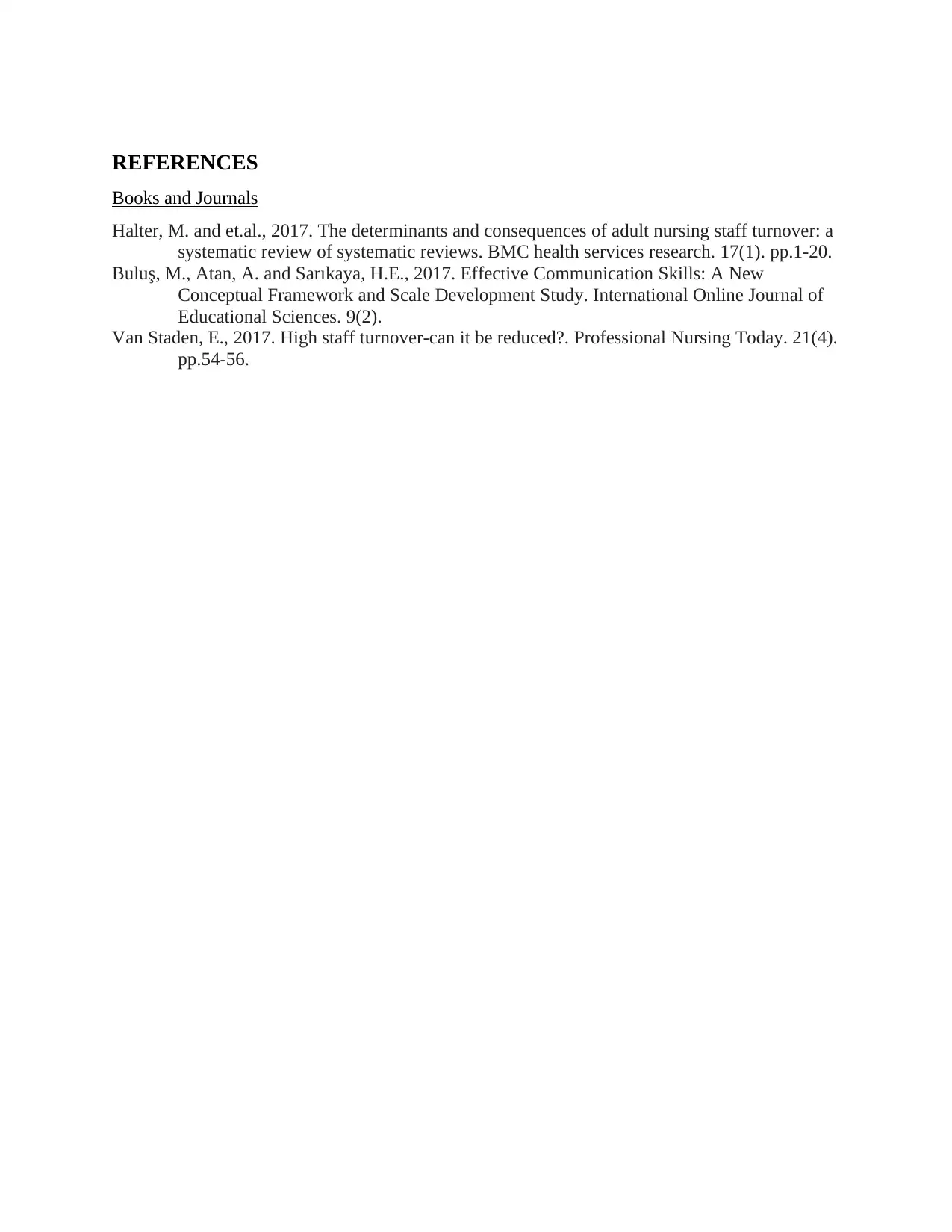
REFERENCES
Books and Journals
Halter, M. and et.al., 2017. The determinants and consequences of adult nursing staff turnover: a
systematic review of systematic reviews. BMC health services research. 17(1). pp.1-20.
Buluş, M., Atan, A. and Sarıkaya, H.E., 2017. Effective Communication Skills: A New
Conceptual Framework and Scale Development Study. International Online Journal of
Educational Sciences. 9(2).
Van Staden, E., 2017. High staff turnover-can it be reduced?. Professional Nursing Today. 21(4).
pp.54-56.
Books and Journals
Halter, M. and et.al., 2017. The determinants and consequences of adult nursing staff turnover: a
systematic review of systematic reviews. BMC health services research. 17(1). pp.1-20.
Buluş, M., Atan, A. and Sarıkaya, H.E., 2017. Effective Communication Skills: A New
Conceptual Framework and Scale Development Study. International Online Journal of
Educational Sciences. 9(2).
Van Staden, E., 2017. High staff turnover-can it be reduced?. Professional Nursing Today. 21(4).
pp.54-56.
⊘ This is a preview!⊘
Do you want full access?
Subscribe today to unlock all pages.

Trusted by 1+ million students worldwide
1 out of 6
Related Documents
Your All-in-One AI-Powered Toolkit for Academic Success.
+13062052269
info@desklib.com
Available 24*7 on WhatsApp / Email
![[object Object]](/_next/static/media/star-bottom.7253800d.svg)
Unlock your academic potential
Copyright © 2020–2025 A2Z Services. All Rights Reserved. Developed and managed by ZUCOL.




